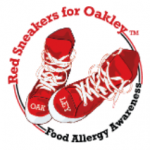In this post, guest author Red Sneakers for Oakley debunks the myth of a “mild” food allergy and explains what they wish they’d known…
We’ve spoken to several people who have told us that they do NOT carry epinephrine for themselves or their child because their food allergy is “mild,” or it “isn’t that bad.”
When we hear that, our hearts sink. Our son Oakley died from (what his doctors called) a “mild” food allergy.
There were so many things we were never taught by our doctors. So many things, in retrospect,
that we would have done differently…
that potentially could have saved our son…
Here are some important things we want you to know:
(1) If you suspect anaphylaxis, EpiFirst—EpiFast, then call 911.
(2) There is no such thing as a “mild” food allergy.
Prior reactions do not predict the severity of future reactions. Someone whose reactions have only been mild in the past may suddenly experience a severe reaction (anaphylaxis) that could be deadly.
(3) Epinephrine is the ONLY first-line medication for anaphylaxis.
Other medications such as antihistamines (like Benadryl or Zyrtec) might calm down hives, but they cannot stop an anaphylactic reaction. If you or your child do not carry epinephrine, and you manage food allergies, please speak to your doctor about obtaining a prescription.
(4) Symptoms of anaphylaxis can sometimes take hours to manifest.
The progression of an anaphylactic reaction can vary. Symptoms can present right away or sometimes take hours to show up. Additionally, symptoms may not always present the same as they presented in previous reactions (e.g., you may have had hives in a previous reaction, but no hives in a subsequent reaction.)
(5) Use epinephrine when mild symptoms involve >1 body system.
When mild symptoms involve more than one body system (for example, nausea {stomach} with a few hives {skin}) after ingesting an allergen, use epinephrine.
(6) Always Carry TWO epinephrine auto-injectors.
Anaphylaxis can be like a runaway train, gathering momentum as it goes and becoming harder to stop as time passes. Sometimes one dose of epinephrine is not enough to stop a reaction and a second dose is needed.
(7) Never delay administering epinephrine. Never hesitate.
Delays in administering epinephrine are an anaphylaxis risk factor and can contribute to fatalities. Epi First—Epi Fast.
(8) Be aware of anaphylaxis cofactors.
Cofactors are patient‐related or external circumstances — for example, exercise — that are associated with more severe allergic reactions. Beyond exercise, there are a variety of other co-factors to be aware of, such as alcohol, stress, infection, and NSAIDs (nonsteroidal anti-inflammatory drugs, e.g., Advil or Motrin or Aleve.) In Oakley’s case, we believe extreme cold, asthma, exercise, and an empty stomach exacerbated his reaction.
(9) Create an Emergency Action {or Care} Plan.
Develop an Emergency Action {or Care} Plan with your allergist and keep it updated. Keep it with your auto-injector. Know it by heart. Share it with others who care for your child.
(10) Be aware of the correct body positioning for anaphylaxis first aid.
Body positioning during anaphylaxis is important because the person’s blood pressure may drop suddenly. During anaphylaxis, lay the person flat, elevate legs and keep warm. If breathing is difficult or they are vomiting, let them sit up or lie on their side.
(11) Read EVERY FOOD LABEL, EVERY TIME.
When there is no food label, like food from a gift basket, do not eat it. You must read every food label. You must read food labels every time, even if you’ve purchased the product before, even if you’ve eaten the product safely before.
(12) Make sure your family and friends understand the dangers.
Communication is key. Make sure your family and friends understand the dangers of food allergies. You can source food allergy facts and information (many printable) from the following trusted sources to help family and friends up the learning curve, including:
- Red Sneakers for Oakley’s Food Allergy Awareness Handbook
- Food Allergy Facts from Kids with Food Allergy
- Food Allergy 101 from FARE
- Food Allergy Basics from FAACT
- Allergic Conditions-Food from ACAAI
Red Sneakers for Oakley seeks to equip you with the best possible data from published sources that can help keep you safe. Thank you @redsneakersforoakley for summarizing this important information and permitting us to share it with the Allergy Force community.
Put on your red sneakers
In memory of Oakley
In support of food allergy awareness

In November 2016, the Debbs Family tragically lost their 11-year-old son, Oakley, to a fatal anaphylactic reaction resulting from a nut allergy. Shortly after Oakley’s death, the family decided to publicly share Oakley’s story to help raise awareness about the dangers of food allergies. They saw a need for awareness and founded the non-profit organization Red Sneakers for Oakley in memory of their son. Oakley wore red sneakers in the multiple sports he played so it was only natural that the family looked to Oakley’s favorite shoes as a powerful symbol to represent the severity of food allergies. Please support @redsneakersforoakley. |
|
… |
|
Credits: Image and content courtesy of Red Sneakers for Oakley


